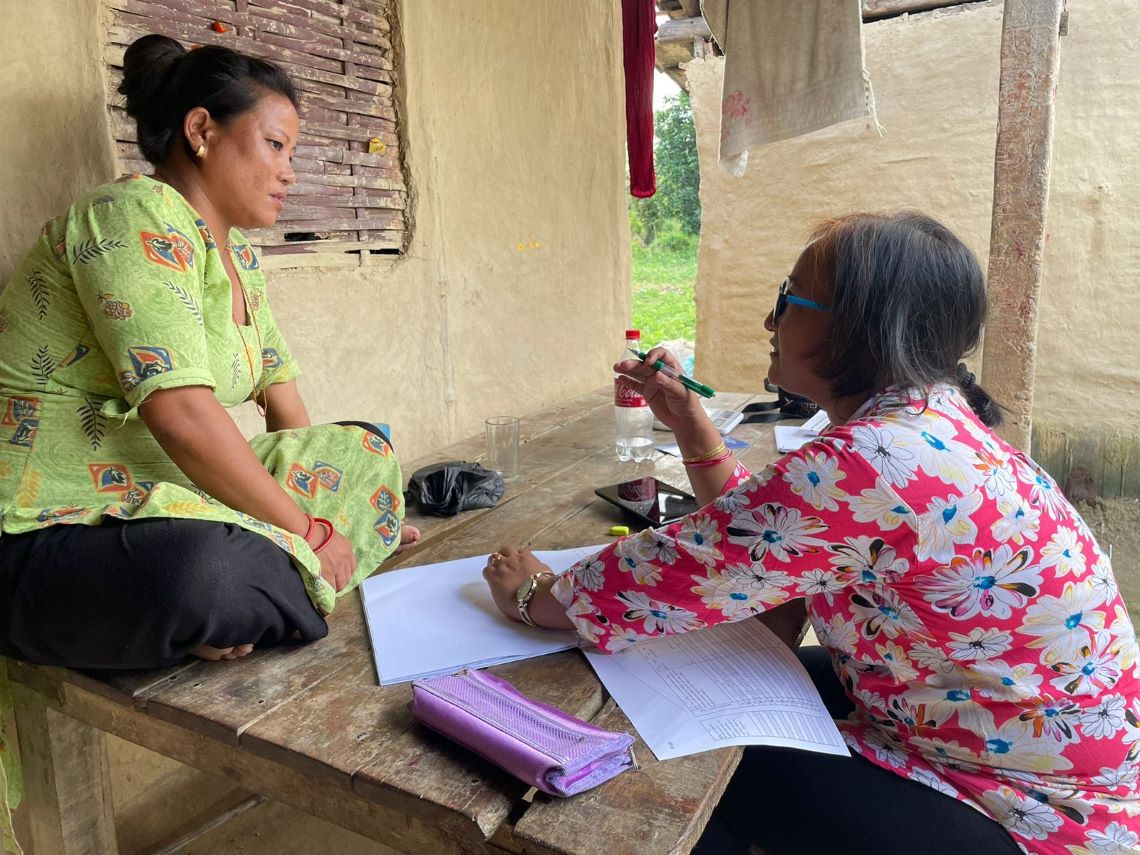 An enumerator conducts Living Standards Survey in Nepal
An enumerator conducts Living Standards Survey in Nepal
Nepal’s recovery from the COVID-19 pandemic is underway. Domestic demand for investment and consumption has recovered, tourists are beginning to return to Nepal as borders reopen, and the numbers of migrant workers leaving the country for overseas employment have returned to pre-pandemic levels.
With growth averaging 4.5 percent per year over the last decade, Nepal also achieved lower middle-income status in 2020 and is aiming for graduation from Least Development Country status by 2026. Improvements are visible in access to electricity and drinking water, increasing primary and secondary school enrollment, and reducing infant mortality. Also, the advent of federalism has meant that the Nepali people not only saw their lives improved but can also aspire for something greater for their children.
Yet, that’s not the whole story of Nepal’s development over the last decade.
The lack of official data on poverty since 2010 has hindered our collective understanding of whether and how growth has translated into improvements in economic welfare for Nepali households over the last decade.
The economy has also sustained several shocks over this time, including the Gorkha earthquake and fuel crisis in 2015, floods in 2017, landslides, and the COVID-19 pandemic in 2020.
COVID-19 induced substantial jobs and income losses in Nepal, and the recovery has been unequal and is incomplete. By the end of 2021, close to a fifth of job losses had not been recovered, and women and those in agriculture and lower skill occupations, were recovering more slowly.
This recovery is also taking place within a weak domestic labor market that relies overwhelmingly on informal and subsistence jobs, as well as pre-existing spatial inequalities in access to human capital and limited social assistance for the poor.
The lack of official data on poverty since 2010 has hindered our collective understanding of whether and how growth has translated into improvements in economic welfare for Nepali households over the last decade.
The Nepali people are well-known for their resilience, and thankfully so. Vulnerability to shocks – both economic and climate – remains an enduring feature of the country’s development story. As risks from climate change and global economic shocks increase, the livelihoods of ordinary Nepali families will continue to be fragile.
So, to sustain development gains, Nepal’s development path must be inclusive of poor and rural households, adapt to a changing climate, and be responsive to shocks. According to the recent Nepal Climate Change Diagnostic Report, about 80 percent of the population is at risk from natural and climate-induced hazards. And vulnerable communities, particularly poorer households and those relying on subsistence agriculture, as well as remote, mountainous municipalities face the highest risks.
To sustain development gains, Nepal’s development path must be inclusive of poor and rural households, adapt to a changing climate, and be responsive to shocks.
An opportunity to capitalize on the promise of federalism
How Nepal responds to these dual challenges of vulnerability and inequality will shape its development storyline. This is because these challenges also present opportunities for shifting the nation’s development investments towards green, resilient, and inclusive growth.
These opportunities are further amplified by the move to federalism. The inherent promise of federalism is the potential for more inclusive and pro-poor governance across the country , through more equitable distribution of resources, greater transparency, and accountability.
The development of a federal data ecosystem that can produce the data needed to inform this transition, and the proactive use of this evidence to design the right policies will therefore be critical to deliver on this promise of improved inclusion and resilience in the country.
Charting the Course
After a long gap of 12 years, the fourth Nepal Living Standards Survey (NLSS-IV) is currently being rolled out in the field. Over the course of a year, 9,600 Nepali households will be interviewed on a range of topics – health, education, jobs, migration, social protection – to provide the data for a much-needed update of Nepal’s poverty statistics, including poverty estimates at the provincial level for the first time.
Thus, the NLSS-IV will provide an evidence baseline for a policy framework to support the fight against poverty and inequality. The World Bank, with the UK Government’s Evidence for Development Program are proud partners of the Central Bureau of Statistics (CBS) in the implementation of the NLSS IV. Many other development partners are equally engaged and committed to this agenda.
After a long gap of 12 years, the fourth Nepal Living Standards Survey (NLSS-IV) is currently being rolled out in the field to provide the data for a much-needed update of Nepal’s poverty statistics, including poverty estimates at the provincial level.
The 2015 Constitution also put in place a fundamental shift in Nepal’s data governance architecture, placing local governments at the forefront of date collection, analysis, and reporting. This is a big shift that will take time to be realized as federalism rolls out and takes hold. It will need careful prioritization to design a decentralized data architecture, one that allows for the right data to be generated, transmitted, and used across all three levels of government.
Given that the move from a centralized to a federal system of governance was largely meant to address historical inequalities, it will be critical to ensure that local data systems integrate citizens voices from the start . Such an emphasis can improve the quality of the data and promote participation and accountability within Nepal’s emerging governance system.
Nepal has demonstrated its commitment to address the challenges to inclusive development, including those posed by climate risks. The government and its development partners adopted the Green, Resilient, and Inclusive Development (GRID) approach in 2021.
The government at all levels is taking concrete steps to integrate climate strategies and actions into development policies, programs, and budgets. The recent World Bank Group’s Country Climate and Development Report for Nepal further supports the government’s GRID approach. The end game is to strengthen household and community resilience. Making this happen requires better governance for climate change and disaster risk management.
While federal institutions need to create the right enabling environment and policy frameworks for a green, resilient, and inclusive Nepal, provincial and local governments will be at the forefront taking action – to protect the vulnerable and excluded, to identify and address emerging risks, and to respond in near time to shocks.
And while federal institutions need to create the right enabling environment and policy frameworks for a green, resilient, and inclusive Nepal, provincial and local governments will be at the forefront taking action – to protect the vulnerable and excluded, to identify and address emerging risks, and to respond in near time to shocks.
A concerted effort to strengthen their capacity to use data and evidence to respond to the dual challenges of vulnerability and exclusion could not come at a better time. It also allows the country to engage in regional and global analysis and comparisons of the impacts of climate change and other shocks, an important precursor to taking collective action with other countries. The World Bank is here to support this historic transition.


Join the Conversation